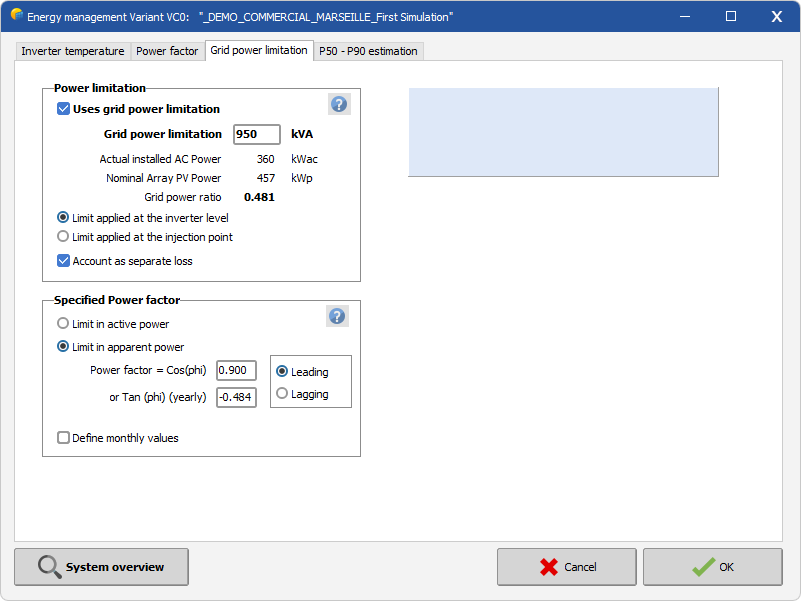Grid power limitation
General
A limit to the injected power is sometimes required by the grid manager.
For maximizing the annual yield, people often install an over-sized PV system (high DC:AC ratio), and accept some energy loss during the best hours of the year (peak-shaving).
In practice, the power limitation cannot be performed at the injection level, since there is no device able to "absorb" any excess power (meaning to dissipate it as heat).
The limitation is rather done at the inverter level, or more exactly at the PV array level. The only way of limiting the power is to not produce it, i.e. to displace the operating point on the array I/V curve, in order to draw just the necessary power. This is the job of the inverter.
In the simulation
The objective is to define an inverter maximum power (Pnom eff) which should correspond to the Grid specified limit power (PNom grid), plus the AC losses after the inverter (wiring, transfos, auxiliaries, etc).
In previous versions (before V 7.3), this was done at the end of each simulation step, by correcting all the simulation calculations from EArray to the injection, for the global system. This was not quite reliable and gave sometimes strange behaviors when the PV system was heterogeneous (different sub-arrays and PNom ratios).
Since the version 7.3, the strategy is different: we may evaluate the maximum power of each inverter (each MPPT) at the beginning of each simulation step, in order to respect the grid limitation.
This pre-evaluation should take several factors into account:
- The nominal power of each MPPT, taking temperature and Power factor into account
- The possible power sharing predefined between MPPT inputs of inverters,
- The different charges of each MPPT input (some with N and some with N+1 strings),
- The possible self-consumption or battery charging for this hour should be added to the grid limit,
- The power sharing between different orientations on a same inverter should be taken into account,
- The grid limit may be specified as Active power [kW] or apparent power [kVA].
After defining the possible PNom of all MPPT's, PVsyst will evaluate their sum Pnom(tot), and diminish some PNom in order to match the required grid limit. The diminution begins with the most charged MPPTs, i.e. those with the higher DC:AC ratio. This is the major difference with the previous calculation on the global system.
With this pre-evaluation of each PNom(eff), the simulation may be performed in the same way as usually. The excess energy will be accounted as "Inverter loss over nominal power".
Now if we want to evaluate separately the loss due to the "normal" Pnom of each inverter, and the contribution of the grid limitation loss (named EUnused in the Loss diagram), we have to recalculate - at each step - the yield of each MPPT, with its nominal PNom.
Procedure
The grid limitation may be defined in the project's dialog, button Energy Management.
Here you can decide whether you have a grid limitation, and specify its value.
The limitation may be defined:
- either at the inverter level: the inverter power is limited to the rated value, and the power injected into the grid is further reduced by the losses defined after the inverter (auxiliaries, AC wiring, transformer).
- or at the injection point level: the maximum power delivered to the grid is indeed the rated limit, the inverter will have to deliver a higher power for compensating the losses after the inverter.
This limitation may be required:
- either as active power (expressed in kW),
- or as apparent power [kVA]: in this case the effective active power [kW] is limited at a lower value than the apparent power limit [kVA]. The Cos(Phi), specific for the grid limitation, may be specified in yearly or monthly values.
The limitation itself will always be managed by the inverter as a clipping loss.
When checking "Account as separate loss", the results will show separately the loss due to the inverter limitation itself, and the loss (named EUnused) due to the additional condition of grid limitation. This does not correspond exactly to the physical behavior of the system, which will always clip at the inverter level, but it is meant to show explicitly the part of the clipping losses due to the injection limitation. When this choice is active, the output variable EOutInv, which usually gives the energy at the output of the inverter, will change slightly its meaning. It will no longer be the true power that one would measure at the inverter outputs, but rather the power that could be achieved if no grid limitation was present. This allows to have a coherent sequence of energy and loss values in the loss diagram.
